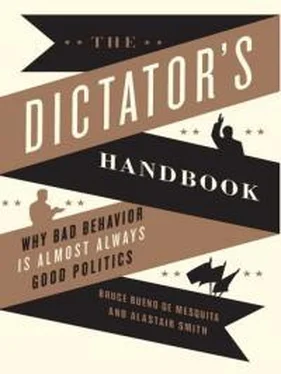Ah, you are thinking, senior management can thwart such efforts. They will, as they already do, hold shareholder meetings in places most owners can’t afford to go, or the meetings will be so brief that it will be impossible for dissidents to express their views (the preferred shareholder meeting strategy in Japan) and, after all, proxies pour in, turning millions of votes over to a handful of board members. None of that, of course, will stop shareholder control once the millions of little owners have a cheap and easy way to exchange views. Then they will set the rules—by majority vote—for who casts proxies. They can set some of their own up to represent competing “parties” and they can make the annual shareholders’ meeting a purely decorative event. All such skeptics should remember that social networking web sites have already successfully mobilized revolutions and brought down governments. Changing corporate governance is far easier.
Corporations don’t have armies that can go out and bash in the heads of dissidents. Pursue a course of connecting and informing shareholders, and we will see whether shareholders who limit CEO salaries do better or worse; whether firms that alter behavior to meet the social expectations of their shareholders do better or worse; and whether shareholders care more about employees or about themselves. Whatever the millions of little owners decide to do, they will be responsible for their own fate. Management will serve them just as democratic leaders are more constrained than autocrats to do what their citizens want.
We also ought to comment a bit on how not to improve corporate governance. In the wake of Enron’s collapse and other big frauds, Congress decided to regulate corporate governance, ostensibly to make it better. By now every reader knows that the interest of government leaders is not in making shareholders or even the man or woman on the street better off. Their interest is in making themselves better off. The regulations they imposed on corporate governance may have played well with voters, many of whom had little stake in many of the companies that were harmed by the regulations, but they have not made corporate governance better. The Sarbanes-Oxley Bill, passed in 2002, was supposed to tamp down management’s greed and make companies responsive to their shareholders’ interest in equity growth. Study after study, however, shows us that this is not what happened. In a brilliant summary of the statistical assessments of each of the governance planks in Sarbanes-Oxley, for instance, Yale law professor Roberto Romano shows that Sarbanes-Oxley did not do what it was “supposed” to do and often made things worse. Even a seemingly obvious reform—requiring an independent audit committee—turns out not to have been beneficial. Costly, yes! But it did not improve corporate governance or performance. Romano goes on to document the failings of Congress and regulators to get it right.2 The wishes of a large coalition of shareholders with a big stake in finding the right answers to any given corporation’s problems is likely to make businesses work better. A coalition of government regulators bent on improving their own electoral prospects is not.
Fixing Democracies
For the citizens of democracies, life is good. But good does not preclude better. At the very beginning we mentioned that we would be lazy and not constantly make subtle distinctions between the size of one democracy’s coalition and another’s. Rather, we have repeatedly leaned on the rhetorical distinction between democracy and autocracy. It is a useful convention, but such a broad brush risks blurring important distinctions. Our approach really depends on the subtle organizational differences in the size of the three political dimensions on which we focus. For convenience, these distinctions are often dropped, but even small differences matter. It is time, then, to confront those small differences head on and see how good can be made better.
At the time of its independence, the United States was composed of thirteen states. They all had broadly the same first-past-the-post electoral rules and yet their record of performance was remarkably different. It is easy to be sloppy and think that they all had the same political system—governed by the United States Constitution—so that their differences must have come from somewhere else. In reality, however, their political systems were not the same. The constitution is silent on many issues that are central to governance. The constitution tells us nothing, for instance, about how to add up votes. As we saw, just by changing this simple rule, Harvey Milk could change American politics by getting elected to San Francisco’s Board of Supervisors in 1977, even though he could not do so in 1975. Seemingly small differences in enfranchisement rules and districting decisions led to big disparities in the economic (and social) development of the States of the United States.
On average, the Northern states developed more rapidly than the Southern states. It is tempting to ascribe this to the traditional historical narratives and attribute the general difference to climate or slavery. However, a careful examination of the subtle differences between the states suggests that variations in their political institutions were the main culprit behind how differently they developed. Jeffrey Jensen, a former student of ours and now a faculty member at NYU, Abu Dhabi, did a very careful study of the differences in the size of the interchangeables, influentials, and essential groups across the original states.3 He understood that many thought the differences in development depended on slavery and climate and so he corrected for these possibilities. Jeff took the size of the slave population carefully into account just as he also took carefully into account how many frost-free days there were per year in each of the original thirteen states. He investigated the distinctions in electoral rules within the early American states that created different levels of dependency on a large or small coalition drawn from a large or small set of interchangeables. His discoveries may not only rewrite how we understand America’s early development, but they can also help us understand how to make our own modern democracy do better.
Who could vote differed greatly from place to place in the early United States. Obviously, slavery played an important—but not decisive—role. For purposes of allocating seats in the House of Representatives (and many state legislatures as well), slaves counted as three fifths of a person, but, of course, they had no right to vote. They were not alone. Women were not given the franchise until the twentieth century, and in the postcolonial period there were sizable genderbalance differences between the states. Some states also imposed substantial property or educational qualifications for voting, while others did not. Electoral districts were typically based upon county lines. Many of these inadequately reflected the population distribution, so in some legislative districts it took vastly more votes to win a seat than in others. The modern principle of one-person, one-vote was not yet the acknowledged law of the land.
The upshot of these differences was that state political leaders were accountable to greatly different numbers of voters—that is interchangeables and essentials. Through painstaking research, Jeff Jensen estimated the proportion of the states’ populations that constituted the minimal winning coalition across states and across the years. It turns out that the size of the group of essentials varied enormously from a low of 8.8 percent of adult white males (and 0.9 percent of the total population) in South Carolina to a high of 23.9 percent of adult white males (and 4.9 percent of the total population) in Pennsylvania.
As the rules to rule by lead us to expect, states in which leaders required support from a larger proportion of the population developed faster. Such states build more extensive canal, rail, and road networks. They also achieved higher educational attainment and were more attractive places for other Americans to migrate into. People left small-coalition states and flocked to big-coalition states where public services were better and all manner of public goods were more extensively provided. Foreign immigrants also flocked to the larger coalition states, even after correcting for proximity to large ports. Per capita incomes were much higher and varied almost directly with coalition size even after correcting for preindependence differences. States with bigger coalitions simply did better.
Читать дальше












